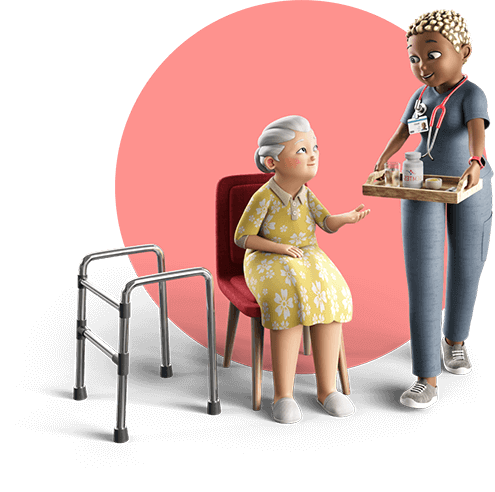SUCCESSFUL MANAGEMENT OF OVERACTIVE BLADDER (OAB) IS CRITICAL IN THE LONG-TERM CARE (LTC) SETTING
Urinary incontinence (UI) may be a symptom of a medical condition called OAB and may affect about 70% of LTC residents in the US 1,2
- From a survey* of 71 directors of nursing (DONs), of LTC residents who suffer from UI, 75% are either always or frequently incontinent3
- According to the same survey, only ~15% of residents received any treatment for UI3
- Up to 78% of women and up to 72% of men in LTC facilities live with UI, but OAB is not often diagnosed4†
*Based on a study of 71 DONs who completed a 30-minute online survey conducted from February 27, 2020 to May 11, 2020.3
†Cross-sectional retrospective analysis of 175,632 nursing facility residents from October 1, 2010 to September 30, 2012.4

Early identification and diagnosis may help residents affected by burdensome OAB symptoms3,5,6
Symptom recognition is a critical first step toward OAB care. As many residents suffer from cognitive decline, they may have difficulty reporting OAB symptoms.‡ Here's what to look for2,7,8:
Urgency (the hallmark symptom)
Sudden, strong urge to urinate immediately
Urge urinary incontinence (UUI)/leakage
Involuntary leakage episodes (which may require use of absorbent products)
Frequency
Urinating 8+ times per day
Many of your residents with OAB may benefit from treatment10
The following considerations may help you identify a resident who may be
struggling with untreated OAB and could benefit from treatment:
 Has been diagnosed with OAB (ICD-10-CM code N32.81||)11
Has been diagnosed with OAB (ICD-10-CM code N32.81||)11 Consistently expresses the need to urgently urinate2
Consistently expresses the need to urgently urinate2 Has had a “triggering event” (such as a fall, UTI, or complaint regarding UI)12-14
Has had a “triggering event” (such as a fall, UTI, or complaint regarding UI)12-14 Rated incontinent based on the MDS 3.0 assessment15¶
Rated incontinent based on the MDS 3.0 assessment15¶ Has been using or is scheduled to use absorbent products regularly16
Has been using or is scheduled to use absorbent products regularly16 Currently uses (or has previously used) an OAB medication that is not (or was not) achieving treatment goals2
Currently uses (or has previously used) an OAB medication that is not (or was not) achieving treatment goals2
||The ICD-10 code is the standard diagnostic tool for epidemiology, health management, and clinical purposes. Nothing in this document is intended to serve as reimbursement advice. The decision about which code to report must be made by the provider/physician considering the clinical facts, circumstances, and applicable coding rules.
¶MDS 3.0 is a resident assessment and care screening criteria for nursing homes.15
ICD=International Classification of Diseases; MDS=minimum data set; UTI=urinary tract infection.

